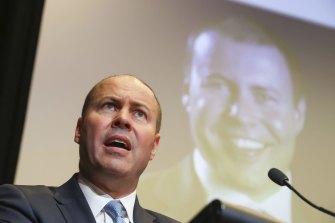Now we’re trying Plan C to end wage stagnation
Be clear on this: Scott Morrison and Josh Frydenberg are dead right to make getting the rate of unemployment down to 4.5 per cent or lower their chief objective, with the further goal of inducing some decent growth in wages. But this approach to economic recovery is very different to our econocrats’ former and more conventional advice.
That the econocrats have changed their tune so markedly is an admission that the way the economy works has changed – in ways they don’t understand, for reasons they don’t understand.

What’s changed most is the behaviour of wages. As Treasury puts it in a new research paper, “structural factors may have altered the wage and price-setting dynamics in advanced economies. These include increased competition in goods markets, increases in services being provided internationally, advances in technology and changes in the supply of labour and labour market regulation”.
That’s an econocrat’s way of saying: who knows what’s going on.
Giving priority to getting unemployment down is always a worthy objective, not only because it greatly improves the lives of those who need to support themselves, but also because households now have more money to spend, making the economy grow faster.

A side-benefit is that it improves the budget balance (more people paying tax, fewer needing to be paid the dole). And promising jobs, jobs, jobs always goes down well with voters.
This time, however, the economic managers have an ulterior motive. They’ve concluded that the only way to get wages growing again is to get unemployment down so far that employers are having trouble finding the workers they need and are forced to compete with other employers by bidding up the wages they’re prepared to pay.
This conclusion may be right – it’s certainly worth trying – but it’s a quite depressing one to come to. And one quite foreign to what the econocrats have been telling us about wages for as long as I’ve been in journalism. It’s a sign of how desperate they’ve become to escape the bog that wages have fallen into.
It’s a tacit acceptance of an obvious point many economists (and I) have been making for ages, but the government and its advisers haven’t been prepared to acknowledge: since consumer spending accounts for well over half of gross domestic product, and growth in wages is the chief source of growth in household incomes, without real growth in wages economic recovery simply isn’t sustainable.
What the econocrats are now saying is that there’s little hope of getting wages growing a percent-or-more faster than annual inflation until you put employers on the rack and generate widespread shortages of labour. To mangle a few metaphors, you’ve got to be right on the tightrope edge of re-igniting a wage-price spiral.
Let your attention wander for a moment and you tip over into a “wage explosion” of the sort we experienced under the Whitlam government and the Fraser government, whose efforts to stop the explosion ended up causing the recessions of the mid-1970s and the early 1980s.
Now, if you find it hard to believe such a disaster is very likely, I do too. As, I’m sure, do the econocrats. But that just means we’re unlikely to get much bidding up of wages, and so are unlikely to get much of an improvement in wage growth if that’s the only way an improvement can come.
Another way of putting this is that the NAIRU (the “non-accelerating-inflation rate of unemployment”) – the lowest unemployment can fall before we get accelerating wages and prices – is unlikely to be nearly as high as Treasury’s latest estimate of 4.5 to 5 per cent.
You need a PhD to know enough maths and stats to be able to run these models, but that doesn’t stop them being cartoon caricatures of the real world. The more so when, by Treasury’s own admission, the world has stopped working the way all the historical figures the model relies on say it does.
The truth is it’s never possible to know where the NAIRU lies until you’ve gone through it and wage growth becomes excessive. That’s a risk the economic managers haven’t been willing to take for decades – which explains why the idea of making restoring full employment the top objective of policy is unfamiliar to anyone who can’t remember as far back as the McMahon government.
But, as Professor Ross Garnaut has reminded us, before the pandemic the Yanks got unemployment down to 3.5 per cent without any sign of labour shortages. If they can, why couldn’t we?
There is, however, an important qualification to the belief that our NAIRU is well south of 4.5 per cent. Shortages of labour are a lot more likely for as long as our borders remain closed.
To see how much what we’re now being told is the path to healthy wage growth differs from what we’ve been told in the past, remember this. Over the 15 years to the end of 2012, wages – as measured by the wage price index – rose by 70 per cent, well ahead of the 53 per cent rise in consumer prices.
Over the eight years to last December, however, wages rose by 19 per cent, not much more than the 15 per cent rise in consumer prices. That’s what the fuss is about: since 2012, wages have barely risen faster than prices.
But in each of the six budgets up to the one in 2019, the econocrats told us the same story: don’t worry. The problem was cyclical. Wage growth may be weak again this year, but the economy was just a bit slow to recover from the global financial crisis and, in a year or two’s time, annual growth would be back to the 3 per cent or so we were used to.
“Just wait a little longer” was Plan A for getting wage growth back to a healthy rate. It didn’t work. As this solution started to wear thin, the rhetoric shifted to Plan B: well, of course, any real growth in wages must come from improvement in the productivity of labour, and it’s been pretty slow of late. So, if you want higher wages, think of something to get productivity up.
Plan B didn’t prove much. It’s not clear that what little productivity improvement we have been getting has flowed through to wages. And, in any case, you can make a good argument that the relationship also flows the other way: that the weak growth in wages is actually helping keep productivity improvement low by holding back consumer spending and thus any motivation for businesses to invest in bigger and better equipment and structures.
So now we’re onto Plan C: let’s engineer labour shortages and see if that works.
Start your day informed
Our Morning Edition newsletter is a curated guide to the most important and interesting stories, analysis and insights. Get it delivered to your inbox.
Ross Gittins is the Economics Editor of The Sydney Morning Herald.
Most Viewed in Business
Source: Thanks smh.com